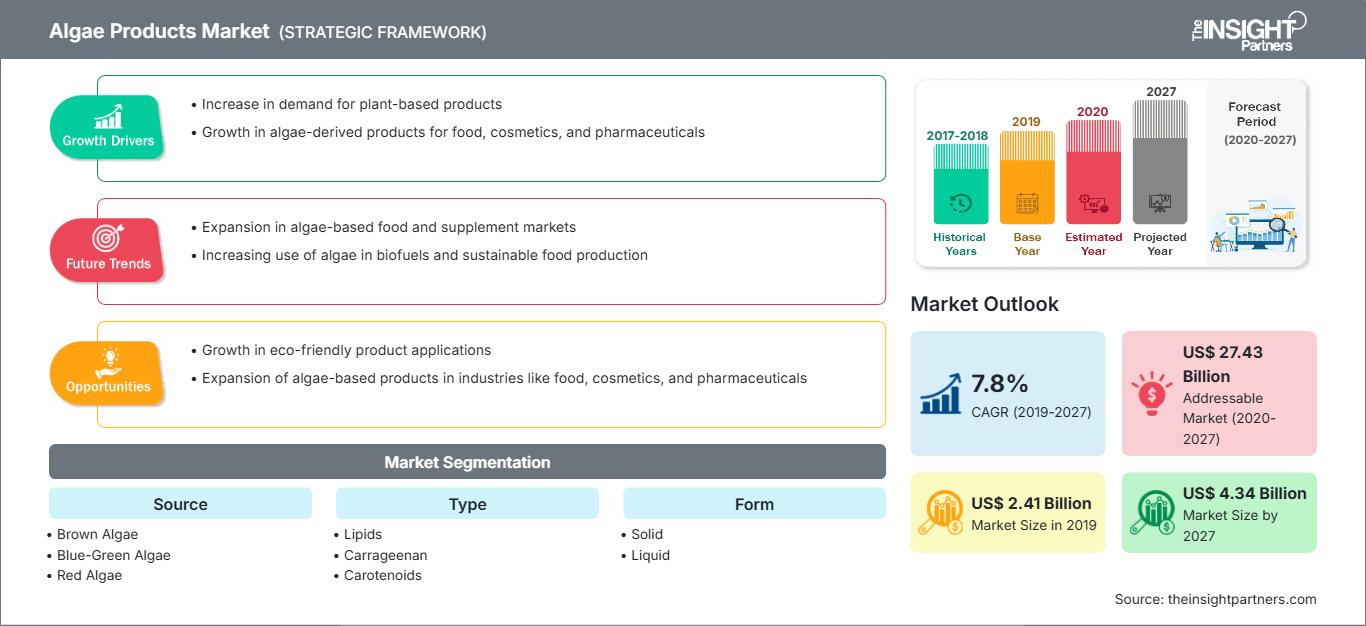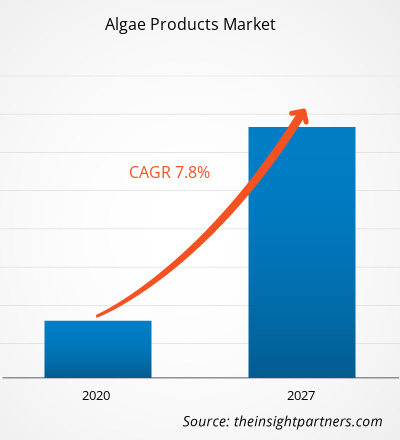[Rapporto di ricerca]Il mercato dei prodotti a base di alghe è stato valutato a 2.405,5 milioni di dollari nel 2019 e si prevede che raggiungerà i 4.339,3 milioni di dollari entro il 2027; si prevede una crescita a un CAGR del 7,8% dal 2020 al 2027.
Le alghe stanno emergendo come una delle fonti più promettenti e sostenibili a lungo termine di combustibile, cibo, mangimi e altri coprodotti per biomassa e oli, grazie ai numerosi vantaggi e alla facilità di produzione. Le alghe si sono evolute nel corso di un miliardo di anni per produrre e immagazzinare energia in modo efficiente, a differenza di qualsiasi altro processo naturale o ingegnerizzato noto. Inoltre, le microalghe possono essere coltivate fino a raggiungere un elevato contenuto di proteine e oli per produrre biocarburanti o mangimi per animali, o entrambi. Inoltre, la biomassa microalgale, ricca di micronutrienti, viene già utilizzata per integratori alimentari volti a migliorare la salute umana. L'applicazione più critica nel mercato alimentare è l'utilizzo di biomassa di microalghe intere come integratore alimentare. Le microalghe sono anche utilizzate come fonte di ingredienti alimentari, tra cui carotenoidi e acidi grassi omega-3. Analogamente, l'agar-agar viene utilizzato come sostituto della gelatina nell'industria alimentare e nella produzione di creme, salse, maionese, gelatine, creme pasticcere, budini, formaggi fusi e prodotti lattiero-caseari surgelati. Viene anche utilizzato in confetture e marmellate per gelificare e addensare, e come agente anti-essiccante in pane e prodotti da forno. Inoltre, l'agar-agar viene utilizzato come addensante in gelati e altri dessert. Pertanto, i prodotti a base di alghe fungono da fonte alimentare alternativa e ingrediente alimentare, trainando la crescita del mercato dei prodotti a base di alghe.
Il Nord America ha rappresentato la quota di mercato più elevata nel 2019. Inoltre, si prevede che l'area Asia-Pacifico registrerà un tasso di crescita redditizio durante il periodo di previsione, ovvero dal 2020 al 2027. Negli Stati Uniti e in altre parti del mondo, le alghe sono comunemente utilizzate come integratori alimentari che aiutano a rafforzare il sistema immunitario, riparare il tessuto nervoso, normalizzare la glicemia e fornire proteine e fibre aggiuntive all'organismo. Le alghe vengono raccolte in Cina e Giappone per l'alimentazione umana da oltre 4.000 anni.
Personalizza questo rapporto in base alle tue esigenze
Potrai personalizzare gratuitamente qualsiasi rapporto, comprese parti di questo rapporto, o analisi a livello di paese, pacchetto dati Excel, oltre a usufruire di grandi offerte e sconti per start-up e università
Mercato dei prodotti a base di alghe: Approfondimenti strategici

- Ottieni le principali tendenze chiave del mercato di questo rapporto.Questo campione GRATUITO includerà l'analisi dei dati, che vanno dalle tendenze di mercato alle stime e alle previsioni.
Impatto della pandemia di COVID-19 sul mercato dei prodotti a base di alghe
Potrai personalizzare gratuitamente qualsiasi rapporto, comprese parti di questo rapporto, o analisi a livello di paese, pacchetto dati Excel, oltre a usufruire di grandi offerte e sconti per start-up e università
Mercato dei prodotti a base di alghe: Approfondimenti strategici

- Ottieni le principali tendenze chiave del mercato di questo rapporto.Questo campione GRATUITO includerà l'analisi dei dati, che vanno dalle tendenze di mercato alle stime e alle previsioni.
Gli Stati Uniti hanno il numero più alto di casi confermati di coronavirus, rispetto a Canada e Messico. La pandemia di COVID-19 continua a imporre la chiusura temporanea di negozi al dettaglio e impianti di produzione nei paesi del Nord America, segnalando un'interruzione senza precedenti del commercio. Rivenditori e marchi si trovano ad affrontare diverse sfide a breve termine in materia di salute e sicurezza, catena di approvvigionamento, forza lavoro, flusso di cassa, domanda dei consumatori e marketing. In Nord America, i negozi hanno iniziato a chiudere all'inizio di marzo e si prevede che questa tendenza continuerà mentre città e stati lottano per contenere la diffusione del virus. Inoltre, la pandemia di COVID-19 sta rapidamente accelerando la tradizione del commercio digitale. Mentre alle persone viene consigliato di seguire il distanziamento sociale, gli ordini di e-commerce per medicinali, alimenti e bevande essenziali sono diventati uno strumento di sopravvivenza per la popolazione del Nord America.
Market Insights Crescita esponenziale nel mercato dei biocarburanti
Nell'ultimo decennio, l'industria delle alghe ha faticato a mantenere il mercato dei biocarburanti. Tuttavia, il prodotto ha il potenziale per raggiungere un'enorme portata una volta che i produttori supereranno le barriere critiche associate alla produzione di materie prime, ai costi di capitale e ai volumi di produzione. Si prevede che l'introduzione di obblighi sui biocarburanti in tutto il mondo costringerà i produttori a investire maggiormente in ricerca e sviluppo durante il periodo di previsione per sviluppare tecnologie sostenibili per la produzione di carburante da alghe. Inoltre, i biocarburanti sono considerati una delle fonti di energia rinnovabile più promettenti per affrontare la crisi energetica globale e le problematiche ambientali. La biomassa di microalghe ha dimostrato la capacità di elaborare biocarburanti, prodotti chimici e beni di origine biologica, contribuendo alla transizione da un'economia basata sul petrolio a un'economia basata sulla bioeconomia. Il biocarburante da alghe offre vantaggi come un tasso di crescita più elevato senza concorrenza alimentare e un impatto ambientale minimo o nullo. Il biocarburante prodotto dalle microalghe presenta una bassa viscosità e una bassa densità rispetto al biocarburante cellulosico ad alto valore calorico, rendendolo più adatto all'applicazione.
Approfondimenti di mercato basati sulle fonti
In base alle fonti, il mercato dei prodotti a base di alghe è segmentato in alghe brune, alghe verdi-azzurre, alghe rosse, alghe verdi e altre. Il segmento delle alghe brune ha guidato il mercato dei prodotti a base di alghe nel 2019.
Approfondimenti di mercato basati sulla tipologia
Il mercato dei prodotti a base di alghe è segmentato in base alla tipologia in lipidi, carragenina, carotenoidi, alginato, proteine algali e altri. Il segmento dei carotenoidi ha guidato il mercato dei prodotti a base di alghe nel 2019.
Approfondimenti di mercato basati sulla forma
Il mercato dei prodotti a base di alghe è frammentato in base alla forma in solido e liquido. Il segmento solido ha guidato il mercato dei prodotti a base di alghe nel 2019.
Approfondimenti di mercato basati sulle applicazioni
Il mercato dei prodotti a base di alghe, in base all'applicazione, è segmentato in alimenti e bevande, nutraceutici e integratori alimentari, prodotti per la cura della persona, mangimi, prodotti farmaceutici e altri. Il segmento nutraceutici e integratori alimentari ha guidato il mercato dei prodotti a base di alghe nel 2019.
Le strategie di crescita organica sono le strategie comunemente adottate dalle aziende per espandere la propria portata di mercato. Cyanotech Corporation, DSM e Algatech Ltd sono tra gli attori del mercato che stanno implementando questa strategia per ampliare la base clienti e acquisire quote di mercato significative a livello globale, il che, a sua volta, consente loro di mantenere il proprio marchio nel mercato globale dei prodotti a base di alghe.
Approfondimenti regionali sul mercato dei prodotti a base di alghe
Le tendenze regionali e i fattori che influenzano il mercato dei prodotti a base di alghe durante il periodo di previsione sono stati ampiamente spiegati dagli analisti di The Insight Partners. Questa sezione illustra anche i segmenti e la geografia del mercato dei prodotti a base di alghe in Nord America, Europa, Asia-Pacifico, Medio Oriente e Africa, America Meridionale e Centrale.
Ambito del rapporto sul mercato dei prodotti a base di alghe
| Attributo del rapporto | Dettagli |
|---|---|
| Dimensioni del mercato in 2019 | US$ 2.41 Billion |
| Dimensioni del mercato per 2027 | US$ 4.34 Billion |
| CAGR globale (2019 - 2027) | 7.8% |
| Dati storici | 2017-2018 |
| Periodo di previsione | 2020-2027 |
| Segmenti coperti |
By Fonte
|
| Regioni e paesi coperti | Nord America
|
| Leader di mercato e profili aziendali chiave |
|
Densità degli operatori del mercato dei prodotti a base di alghe: comprendere il suo impatto sulle dinamiche aziendali
Il mercato dei prodotti a base di alghe è in rapida crescita, trainato dalla crescente domanda da parte degli utenti finali, dovuta a fattori quali l'evoluzione delle preferenze dei consumatori, i progressi tecnologici e una maggiore consapevolezza dei benefici del prodotto. Con l'aumento della domanda, le aziende stanno ampliando la propria offerta, innovando per soddisfare le esigenze dei consumatori e sfruttando le tendenze emergenti, alimentando ulteriormente la crescita del mercato.

- Ottieni il Mercato dei prodotti a base di alghe Panoramica dei principali attori chiave
- Alghe brune
- Alghe verdi-azzurre
- Alghe rosse
- Alghe verdi
- Altri
Mercato dei prodotti a base di alghe - Per tipo
- Lipidi
- Carragenina
- Carotenoidi
- Alginato
- Proteine algali
- Altri
Mercato dei prodotti a base di alghe - Per forma
- Solido
- Liquido
Mercato dei prodotti a base di alghe - Per applicazione
- Alimenti e bevande
- Nutraceutici e integratori alimentari
- Cura della persona Prodotti
- Mangimi
- Prodotti farmaceutici
- Altro
Profili aziendali
- Algatechnologies Ltd
- Algenol
- BASF SE
- Cargill Incorporated.
- Cellana Inc.
- Corbion nv
- CP Kelco (JM Huber- Corporation
- Cyanotech Corporation.
- DSM Nutritional Products AG
- EID Parry Limited
- Analisi storica (2 anni), anno base, previsione (7 anni) con CAGR
- Analisi PEST e SWOT
- Valore/volume delle dimensioni del mercato - Globale, Regionale, Nazionale
- Industria e panorama competitivo
- Set di dati Excel
Report recenti
Testimonianze
Motivo dell'acquisto
- Processo decisionale informato
- Comprensione delle dinamiche di mercato
- Analisi competitiva
- Analisi dei clienti
- Previsioni di mercato
- Mitigazione del rischio
- Pianificazione strategica
- Giustificazione degli investimenti
- Identificazione dei mercati emergenti
- Miglioramento delle strategie di marketing
- Aumento dell'efficienza operativa
- Allineamento alle tendenze normative




















 Ottieni un campione gratuito per - Mercato dei prodotti a base di alghe
Ottieni un campione gratuito per - Mercato dei prodotti a base di alghe